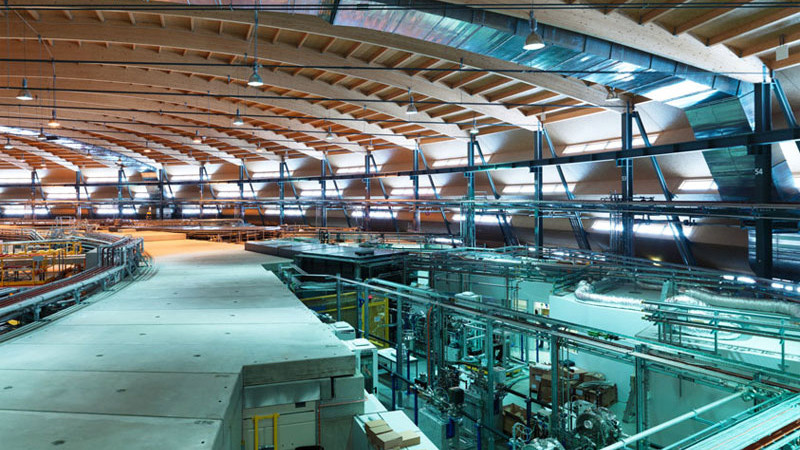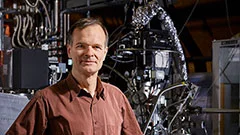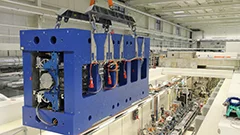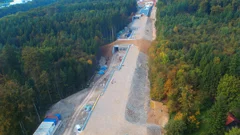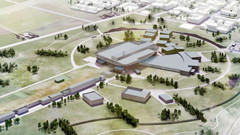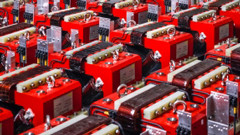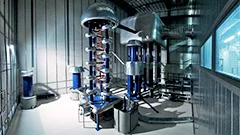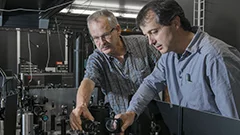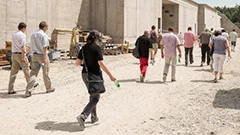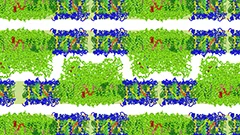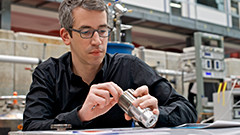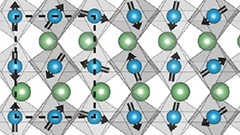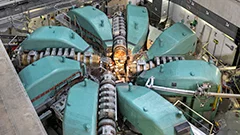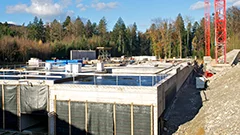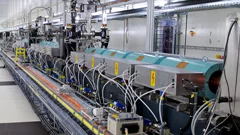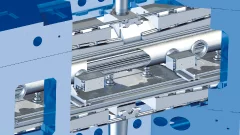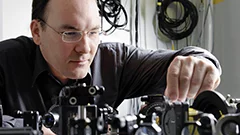Large Research Facilities
Sometimes, one needs unusually large pieces of equipment to look at the smallest of objects – because only these large machines or facilities can generate the probes
that are needed to examine matter in such a way that the information being sought can be obtained. PSI maintains a number of such facilities, making them available as a service for other institutions, but also using them for its own research. These facilities are unique within Switzerland, and PSI is the only location in the world for some of the facilities
Read more at: Large Research Facilities
Further information
Research geared towards the future
Interview with Gabriel AeppliGabriel Aeppli has been head of synchrotron radiation and nanotechnology research at PSI since 2014. Previously, the Swiss-born scientist set up a leading research centre for nanotechnology in London. In this interview, Aeppli explains how the research approaches of the future can be implemented at PSI's large research facilities and talks about his view of Switzerland.
Split x-ray flash shows rapid processes
SwissFEL, PSI’s x-ray laser, is to render the individual steps of very rapid processes visible. A new method will facilitate especially precise experiments: the individual x-ray flashes are split into several parts that arrive at the object under examination one by one. The principle of the method harks back to the ideas of the earliest high-speed photography.
Prepared for the SwissFEL
For many years, PSI researchers have been testing experimental methods that will provide insights into novel materials for electronic devices. Using a special trick to make the Swiss Light Source (SLS) at PSI generate light with similar properties to that of PSI’s x-ray laser SwissFEL, the researchers were able to demonstrate that the experiments planned for SwissFEL are possible and they are now building an experimental station at SwissFEL.
SwissFEL ready for assembly
Researchers from PSI have spent the last four years developing key technologies for the X-ray laser SwissFEL and subjecting them to the acid test in the injector test facility. Now that the development programme has drawn to a close, the installation of the new large research facility is due to get underway in early 2015.
A large research facilities disappears in the woods
The building of the new PSI large research facility SwissFEL in Würenlingen forest could only enjoy the sunshine for a brief spell: it is now disappearing under a mound of earth. This superstructure is one of the measures taken to integrate the facility as harmoniously as possible into the natural environment.
Foundation Stone Ceremony Marks Scientific Importance of ESS
Today, several hundred members of the European scientific community gathered at the European Spallation Source (ESS) construction site in Lund, Sweden, for the ESS Foundation Stone Ceremony. The event was held to lay the foundation’ both for the new facility, which has recently begun construction, and for a new generation of science in Europe.
Giants who control miniscule particles
Magnets are the unsung heroes in particle accelerators because they keep protons or electrons on track. But such magnets have very little in common with the small ones on the domestic fridge door. Quite a few of the magnets at PSI are heavier and bulkier than the fridge itself, yet despite this they are also masterpieces of precision and control.
A reliable type from the 1980s
The source of the proton beam at PSI is a retro-style Cockcroft-Walton linear accelerator. Since 1984 it has been the first acceleration stage for protons which are taken up to around 80 percent of the speed of light by two further ring accelerators. This has resulted in the generation of a significant proton beam over decades, and which has even held the world record as the highest performing beam since 1994 thanks to ongoing retrofitting.
New material generated with light
PSI researchers garner experience for SwissFEL experimentsAided by short laser flashes, researchers at the Paul Scherrer Institute have managed to temporarily change a material’s properties to such a degree that they have à to a certain extent àcreated a new material. This was done using the x-ray laser LCLS in California. Once the PSI x-ray laser SwissFEL is up and running, experiments of this kind will also be possible at PSI.
Tag der offenen SwissFEL-Baustelle
Vergangenen Sonntag luden das Paul Scherrer Institut PSI und die Arbeitsgemeinschaft EquiFEL Suisse die Einwohnerinnen und Einwohner der Umgebung zum Tag der offenen SwissFEL-Baustelle ein. Rund 600 Interessierte informierten sich an mehreren Stationen über den aktuellen Bau- und Projektstand.This news release is only available in German.
New insight into photosynthesis
The way that algae and plants respond to light has been reinterpreted based on results from recent experiments. Under particular lighting conditions during photosynthesis, the well-ordered stacking and alignment of light-sensitive membranes in the algae are disrupted. There is no significant movement of the membrane embedded light harvesting proteins, which rather become largely inactive. These new findings challenge widely accepted views of how algae respond to light where the light harvesting proteins were thought to move around the membranes.
Big building on a millimetre scale
For the electrons to reach the necessary energy level, their path in the linear accelerator needs to be absolutely straight. Even the slightest bend means a loss of energy, which the comparatively short SwissFEL linear accelerator cannot afford. Consequently, even the earth’s curvature needs to be balanced out while constructing the building, which not only requires state-of-the-art measurement technology, but also continuous monitoring.
Quantum melting
Changes to the aggregate state triggered by quantum effects à in physically correct terms, quantum phase transitions à play a role in many astonishing phenomena in solids, such as high-temperature superconductivity. Researchers from Switzerland, Great Britain, France and China have now specifically altered the magnetic structure of the material TlCuCl3 by exposing it to external pressure and varying this pressure. With the aid of neutrons, they were able to observe what happens during a quantum phase transition, where the magnetic structure melts quantum-physically.
Observed live with x-ray laser: electricity controls magnetism
Researchers from ETH Zurich and the Paul Scherrer Institute PSI demonstrate how the magnetic structure can be altered quickly in novel materials. The effect could be used in efficient hard drives of the future.
The proton accelerator at the Paul Scherrer Institute: forty years of top-flight research
Materials research, particle physics, molecular biology, archaeology à for the last forty years, the Paul Scherrer Institute’s large-scale proton accelerator has made top-flight research possible in a number of different fields.
The art of tailor-made engineering
Preventing SwissFEL electrons from going astrayCost-effective and with a minimal error rate àPSI-engineers from the power electronics section have set ambitious goals for the SwissFEL magnet power supplies.
High-tech right up to the roof
The construction work in the woods is well underway: the building for SwissFEL, the Paul Scherrer Institute’s new large research facility, is due for completion by the end of 2014. The demands on the building are high: It needs to ensure that the sensitive equipment can run smoothly.
The SwissFEL facility: laser light from avalanche-like amplification
SwissFEL will create X-ray light with laser-like characteristics. The strong amplification of the light needed is produced by a process known as micro-bunching à electron packets break up in the undulator into thin layers which emit light in phase. At the same time, another process called seeding is being studied, in which one will be able to establish the properties of the light even more precisely.
The SwissFEL facility: the undulator section – where the light is produced
X-ray light is produced in SwissFEL when electrons accelerated in its linear accelerator are forced to follow a wavy path. This takes place within the undulators à regular arrangements of magnets that bend the electron beam. The whole undulator section will be 60 metres long.
Magnetisation controlled at picosecond intervals
A terahertz laser developed at the Paul Scherrer Institute makes it possible to control a material’s magnetisation precisely at a timescale of picoseconds. In their experiment, the researchers shone extremely short light pulses from the laser onto a magnetic material. The light pulse’s magnetic field was able to deflect the magnetic moments from their idle state in such a way that they exactly followed the change of the laser’s magnetic field with only a minor delay. The terahertz laser used in the experiment is one of the strongest of its kind in the world.
